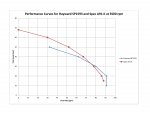Sorry for the late response. So essentially, the powerflo matrix 1.5 moves more water, if that's full rated.
Speck pumps compared to Hayward
- Thread starter Metallica
- Start date
You are using an out of date browser. It may not display this or other websites correctly.
You should upgrade or use an alternative browser.
You should upgrade or use an alternative browser.
- May 3, 2007
- 16,989
- Pool Size
- 20000
- Surface
- Plaster
- Chlorine
- Salt Water Generator
- SWG Type
- Hayward Aqua Rite (T-15)
I am not sure what you are asking here.
An SPL rated motor is simply the equivalent of a full rated motor that is 1 HP less. So the label HP is somewhat deceiving and the motor is not as big as it appears to be. Therefore within the same pump line, a pump with a 2 HP SPL motor will have the SAME performance as a 1.5 HP up rated motor or a 1 HP full rated motor. All three pumps will use the same wet end parts and have exactly the same performance but their labels will be different which can cause some confusion.
But because of this "labeling" quirk, you really should not compare pumps by their HP labels. This will often lead to the wrong conclusion. To properly compare pumps, you really need to look at each pump's head curve. If the head curves are similar, the performance will be similar.
Also, any time a pump "moves more water", it is usually less efficient. So to increase efficiency, you actually want to move less water. Moving water faster takes more energy and more $$$.
An SPL rated motor is simply the equivalent of a full rated motor that is 1 HP less. So the label HP is somewhat deceiving and the motor is not as big as it appears to be. Therefore within the same pump line, a pump with a 2 HP SPL motor will have the SAME performance as a 1.5 HP up rated motor or a 1 HP full rated motor. All three pumps will use the same wet end parts and have exactly the same performance but their labels will be different which can cause some confusion.
But because of this "labeling" quirk, you really should not compare pumps by their HP labels. This will often lead to the wrong conclusion. To properly compare pumps, you really need to look at each pump's head curve. If the head curves are similar, the performance will be similar.
Also, any time a pump "moves more water", it is usually less efficient. So to increase efficiency, you actually want to move less water. Moving water faster takes more energy and more $$$.
I appreciate everything you've educated me on. So I in reality have a 1hp pump. Also, when you say "head" are you referring to the distance of flow from the jet? If you could explain that it would be greatly appreciated.
Head is a measure of pressure it's related to a column of water. Anything that affects the flow increases the head pressure. Pumps are rated in how many feet of head they can pump. If you look at the chart above and the Hayward you'll see that the line stops at 50' of head. Translated, that means that if there was zero suction head and you stood a pipe vertically 50' high, the pump wouldn't produce enough pressure to push water out the top of it. That's a little simplistic but that's basically how it works. Even horizontally, each fitting, length of pipe, rise or fall in elevation, changes the head loss. Lower the pump below the surface of the water and it actually lowers the head loss, raise it above the water level and it increases the head loss.
To read the chart you use the column on the left for head and the line along the bottom for flow. If you know the head loss you find it on the column and follow that line across to where the pump curve intersects the line and then follow the vertical line down to find the flow. (I.E. you know you have 30' of head you follow the line to where the curve intersects the 30' of head line, then go from that point straight down and you'll see that it's almost 80 gpm). Inversely if you know the flow you find it on the bottom line and then follow that line up to where the curve intersects the line then follow that straight across to the head column.
To read the chart you use the column on the left for head and the line along the bottom for flow. If you know the head loss you find it on the column and follow that line across to where the pump curve intersects the line and then follow the vertical line down to find the flow. (I.E. you know you have 30' of head you follow the line to where the curve intersects the 30' of head line, then go from that point straight down and you'll see that it's almost 80 gpm). Inversely if you know the flow you find it on the bottom line and then follow that line up to where the curve intersects the line then follow that straight across to the head column.
Thread Status
Hello , This thread has been inactive for over 60 days. New postings here are unlikely to be seen or responded to by other members. For better visibility, consider Starting A New Thread.


